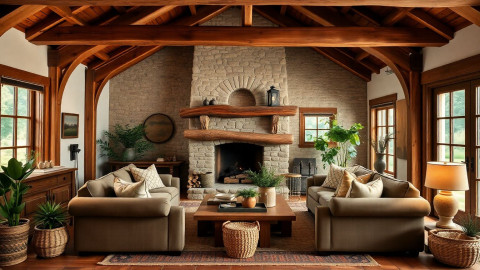Embracing the Boho Spirit: A Comprehensive Guide to Bohemian Interior Design

Bohemian interior design, with its vibrant colors, eclectic patterns, and free-spirited ambiance, has captured the hearts of design enthusiasts worldwide. Rooted in the artistic movements of 19th century Paris, this style has evolved into a celebration of individuality, creativity, and global influences. From cozy living rooms adorned with vintage textiles to sun-drenched bedrooms filled with lush plants, boho interiors invite us to break free from conventional design rules and embrace our unique aesthetic sensibilities. In this comprehensive guide, we'll explore the essence of bohemian design, uncover its key elements, and provide expert tips to help you create a space that truly reflects your personality and wanderlust.
The Origins and Evolution of Bohemian Style
To truly understand and appreciate bohemian interior design, it's essential to delve into its rich history. The term 'bohemian' originates from Bohemia, a region in the present-day Czech Republic. However, its association with an unconventional lifestyle began in 19th century Paris, where artists, writers, and intellectuals rejected the bourgeois norms in favor of a more creative and free-spirited existence.
Catherine Davin, co-founder of Clairrow, explains, "The term bohemian means unconventional and artistic, and that's a great way to define this design style. It has its origins in 19th century Paris, where artists who rejected the lifestyle of French bourgeois moved to new areas of the city – these new areas were focused on creativity and artistic expression rather than wealth and status."
This rebellious spirit has remained at the core of bohemian style, evolving over time to incorporate influences from various cultures and artistic movements. The hippie culture of the 1960s and '70s further popularized boho aesthetics, infusing it with elements of nature, spirituality, and global artisanship.
Today, bohemian interior design represents a harmonious blend of vintage and modern, combining elements from different eras and cultures to create spaces that are both nostalgic and forward-thinking. It's a style that celebrates individuality, encouraging homeowners to curate environments that tell their unique stories.
Key Elements of Bohemian Interior Design
1. A Vibrant Color Palette
One of the most distinctive features of bohemian interiors is their bold and eclectic use of color. While there's no strict rule for color selection, boho spaces often incorporate a mix of earthy tones and vibrant hues. Karen Rohr, an interior designer at Mackenzie Collier Interiors, notes, "The bohemian color palette is full of earthy tones and natural hues. Think muted jewel tones, soft pastels, and deep, rich colors inspired by nature."
To incorporate this element into your space:
- Start with a neutral base and layer in pops of color through textiles, artwork, and accessories.
- Don't be afraid to mix different color families – unexpected combinations often yield the most striking results.
- Consider using colorful Moroccan-inspired tiles for a kitchen backsplash or bathroom floor to add a bold boho touch.
2. Layered Textures and Patterns
Boho interiors are a feast for the senses, particularly when it comes to textures and patterns. The key is to create a rich, layered look that feels both curated and effortlessly chic. Edyta Haligowska, CEO and Lead Designer of HE Space Design, suggests, "Using vibrant colors and patterned textiles on drapery, rugs, and pillows – layered for ultimate effect. Embellishments like fringe and tassels give an added boho touch."
To master the art of layering:
- Mix different fabric textures such as silk, wool, cotton, and jute.
- Combine patterns of varying scales – pair large-scale prints with smaller, more intricate designs.
- Incorporate natural textures through woven baskets, macramé wall hangings, and wooden furniture.
3. Plants and Natural Elements
Bringing the outdoors in is a fundamental aspect of bohemian design. Indoor plants not only add visual interest but also contribute to a sense of tranquility and connection with nature. Alexandra Davin, co-founder of Clairrow, advises, "You can also do dried plants, like grasses and dehydrated flowers. This is a nice approach if you're going for a more muted color palette, but you want to incorporate the natural feel of greenery."
To incorporate greenery into your boho space:
- Choose a variety of plants in different sizes and textures – from large leafy plants to small succulents.
- Use hanging planters to add vertical interest and save floor space.
- Incorporate natural materials like bamboo, rattan, and jute in your furniture and decor choices.
4. Vintage and Global Influences
Bohemian interiors often feature a mix of vintage finds and globally-inspired pieces. This eclectic approach adds depth and character to the space, creating a sense of worldliness and lived-in charm. Tiffany Gholar, an interior designer, explains, "It's an aesthetic that prioritizes furnishings and accessories that are handmade and globally sourced. It tends to be eclectic and draws from a variety of cultures from around the world."
To incorporate this element:
- Scout flea markets, antique shops, and online marketplaces for unique vintage pieces.
- Display souvenirs and artisanal crafts from your travels.
- Mix furniture styles from different eras and cultures for an eclectic look.
Creating a Boho-Chic Space: Room by Room Guide
Living Room
The living room is often the heart of bohemian homes, serving as a gathering space that reflects the homeowner's personality and travels. To create a boho-chic living room:
- Choose a comfortable, low-profile sofa as your centerpiece.
- Layer rugs of different patterns and textures for a cozy feel.
- Create a gallery wall with a mix of artwork, mirrors, and wall hangings.
- Add floor cushions and poufs for additional seating and a relaxed vibe.
Bedroom
A bohemian bedroom should be a serene retreat that encourages relaxation and self-expression. Consider the following:
- Opt for a canopy bed or add a macramé hanging above the headboard for a dreamy atmosphere.
- Use richly patterned bedding and layer with throws and pillows in contrasting textures.
- Incorporate a vintage dresser or armoire for storage and character.
- Display plants on hanging shelves or in macramé plant hangers.
Kitchen
While kitchens might seem challenging to bohemian-ize, there are several ways to infuse boho charm:
- Replace upper cabinets with open shelving to display colorful dishes and glassware.
- Add a Moroccan-inspired tile backsplash for a pop of pattern and color.
- Use woven baskets for storage and to add texture.
- Hang herbs to dry for both functionality and visual interest.
Bathroom
Transform your bathroom into a boho oasis with these tips:
- Install a statement vanity mirror with an ornate frame.
- Use colorful, patterned towels and a unique shower curtain.
- Add a small area rug or kilim for warmth and texture.
- Display bath products in attractive bottles and jars on a vintage tray.
Embracing the Boho Philosophy
Beyond the aesthetic elements, bohemian interior design is about embracing a certain philosophy of living. It's about creating spaces that feel authentic, lived-in, and deeply personal. As Karen Rohr puts it, "The goal is to showcase your most unique taste and sense of style, no rules."
This approach encourages homeowners to:
- Prioritize comfort and functionality over perfection.
- Display items that have personal meaning or tell a story.
- Embrace imperfections and the beauty of handmade or vintage items.
- Create spaces that evolve over time, reflecting new experiences and inspirations.
Sustainable and Ethical Considerations in Boho Design
As the boho style often draws inspiration from various cultures, it's important to approach this aspect thoughtfully and respectfully. Here are some considerations:
- Research the cultural significance of decorative items before incorporating them into your space.
- Support artisans and fair trade organizations when purchasing globally-inspired pieces.
- Opt for vintage or second-hand items to reduce environmental impact and add unique character to your space.
- Choose sustainable materials like bamboo, organic cotton, and reclaimed wood when possible.
Conclusion: Crafting Your Boho Haven
Bohemian interior design offers a unique opportunity to create a home that truly reflects your personality, experiences, and values. By embracing color, texture, and eclectic influences, you can craft a space that feels both comfortable and inspiring. Remember, there are no strict rules in boho design – the key is to trust your instincts and let your creativity flourish.
As you embark on your bohemian design journey, keep in mind the words of Edyta Haligowska: "The bohemian spirit values nature, so adding flowers and house plants will help enrich the boho interior, and also give back in the form of fresh oxygen – something we all need these days." Let this spirit guide you as you transform your space into a boho haven that nurtures both body and soul.
Whether you're drawn to the vibrant colors, the mix of patterns, or the laid-back lifestyle it represents, bohemian interior design offers something for everyone. So go ahead, break the rules, mix those patterns, and create a space that's uniquely, beautifully you.
Resources for Further Reading
- The New Bohemians by Justina Blakeney
- Bohemian Style: Dress, Interior Design and Art by Elizabeth Wilhide
- The Spruce: 5 Gorgeous Ideas for Bohemian Style Interior Design
- Living Cozy: What Is Bohemian Interior Design? Plus, Expert Tips & Tricks
- Posh Pennies: Boho Home Decor: 11 Tips That Show You How To Pull It Off
By exploring these resources and putting your own spin on bohemian design principles, you'll be well on your way to creating a home that's as unique and free-spirited as you are.
More Articles
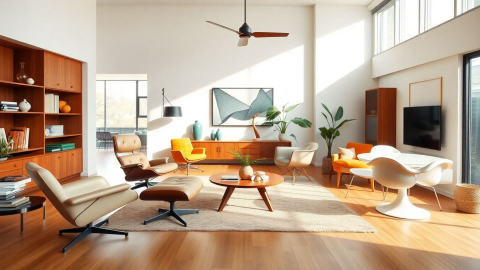
The Timeless Allure of Mid-Century Modern Interior Design: A Comprehensive Guide
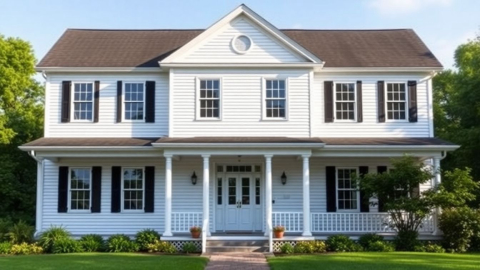
American Colonial Architecture: A Satirical Stroll Through History's Architectural Attic
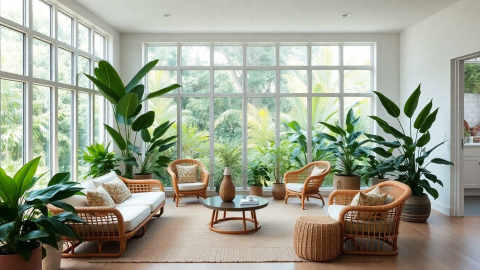
Tropical Interior Design: Creating Paradise Within Your Home
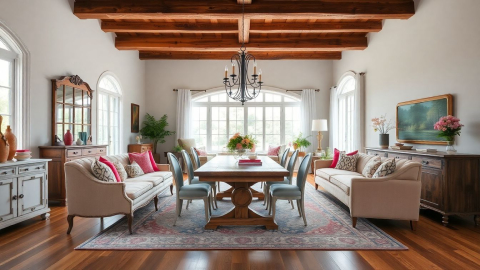
The Timeless Elegance of French Provincial Interior Design: A Comprehensive Guide
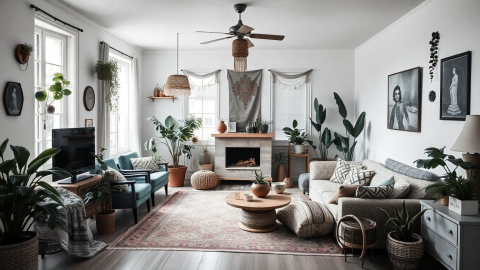
The Art of Bohemian Interior Design: Embracing Free-Spirited Elegance
